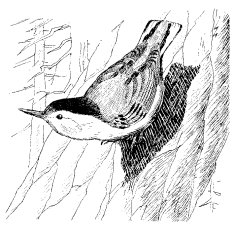
WHITE-BREASTED NUTHATCH
| Online Library: | Title | Author | California | Geology | History | Indians | Muir | Mountaineering | Nature | Management |
Yosemite > Library > Birds of Yosemite > Nuthatches >
Next: Creepers • Contents • Previous: Tits

WHITE-BREASTED NUTHATCH |
Frequents chiefly rough-barked trees such as oaks and conifers. R. from the Upper Sonoran to the Hudsonian life zone, concentrating in the lower zones in winter. Occasionally seen in Yosemite Valley.

RED-BREASTED NUTHATCH |
Frequents chiefly conifers in the Canadian life zone. It especially favors firs in which it often forages at considerable heights. Partially R., many individuals descending in winter to lower levels and to the south. In the Yosemite region common in summer in the Canadian zone but also found in the Transition and Hudsonian zones. To be seen in Yosemite Valley almost all year.
PYGMY NUTHATCH (Sitta pygmaea): 4-4 1/2 in. Above light bluish-gray; head darker or brownish with dark line through eye; white on nape inconspicuous; under parts white or buffy; tail short, outer tail feathers with black and white. Inhabits the trunks and main branches of trees. Often seen feeding in pine-needle clusters. Usually travels in small flocks.
Frequents pine trees and other conifers in the Transition life zone, often foraging at high levels in trees. Uncommon R. in the Yosemite region in the Transition and Canadian life zones. Occasionally seen in late summer and fall around the rim of Yosemite Valley. Rare in Yosemite Valley.
Next: Creepers • Contents • Previous: Tits
| Online Library: | Title | Author | California | Geology | History | Indians | Muir | Mountaineering | Nature | Management |
http://www.yosemite.ca.us/library/birds_of_yosemite/nuthatches.html